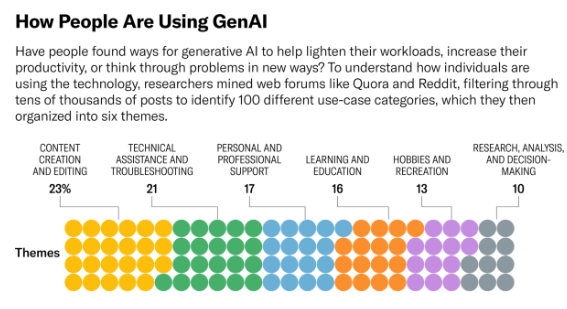
How Generative AI is Transforming Work and Life
In just over a year, generative AI has moved from being a novelty to becoming a transformative tool reshaping how individuals and organisations operate. The Harvard Business Review recently published an article by Marc Zao-Sanders that delves into how people are leveraging generative AI in real-world scenarios. Inspired by this, we’ll explore how this burgeoning technology aligns with the mission of Visualisation Hub to empower innovation and efficiency in healthcare and other sectors.
Unlocking Real-World Use Cases
Generative AI has proven to be a versatile asset across six major themes identified in the HBR article:

-
Technical Assistance & Troubleshooting (23%)
Everyday challenges—whether in IT systems or home appliances—are now being addressed through AI tools, enabling users to troubleshoot and resolve issues faster. -
Content Creation & Editing (21%)
From drafting emails to creating educational content, generative AI simplifies processes while enhancing productivity. -
Personal & Professional Support (17%)
Professionals are using AI for time-saving tasks such as drafting performance appraisals or writing formal letters. -
Learning & Education (16%)
AI provides interactive, personalised learning experiences that cater to diverse needs, from mastering new languages to upskilling in technical domains. -
Creativity & Recreation (13%)
Individuals are discovering new ways to spark creativity, whether brainstorming ideas or generating synthetic art for personal projects. -
Research, Analysis & Decision-Making (10%)
From fact-checking to financial modelling, AI assists in making more informed decisions by synthesising large datasets efficiently.

The Human-AI Collaboration
A standout insight from the article is that the most popular use case for generative AI is idea generation. Unlike traditional automation tools that focus on final outputs, generative AI thrives in “human-plus-machine” collaboration, where humans guide and refine AI-generated suggestions.
For instance, Visualisation Hub leverages generative AI in healthcare to empower clinicians with tools that summarise doctor-patient interactions, translate complex medical language into actionable steps, and optimise communication with patients. These tools amplify human expertise while maintaining a human touch, ensuring accuracy and empathy.
Accessibility Meets Expertise
Another transformative aspect of generative AI is its ability to make traditionally expensive services accessible. As Marc Zao-Sanders notes, generative AI has unlocked areas like law, coding, and healthcare. For Visualisation Hub, this translates into providing healthcare professionals with tools that streamline coding, improve compliance with frameworks like MBS, and generate clinical notes efficiently—all while maintaining the highest standards of privacy and data security.
Experimentation Drives Innovation
The HBR article emphasises the importance of safe and meaningful experimentation with generative AI. Visualisation Hub embraces this ethos by continuously innovating tools that address healthcare's unique challenges. For example, EchoHealth Hub integrates multilingual capabilities, date-stamped SMS communications, and intent recognition—all features designed to improve both patient and clinician experiences.
What’s Next for Generative AI?
As generative AI continues to evolve, its potential for driving productivity, creativity, and inclusivity will expand. Visualisation Hub is committed to staying at the forefront of this transformation by delivering solutions that not only streamline workflows but also empower users to achieve more.
Marc Zao-Sanders’ conclusion resonates deeply with us: “People that don’t find [AI] useful simply haven’t understood how to use it.” At Visualisation Hub, we are dedicated to bridging this gap by building tools and platforms that make generative AI accessible, impactful, and meaningful for all.
Reference:
Marc Zao-Sanders, How People Are Really Using GenAI, Harvard Business Review, March 2024.